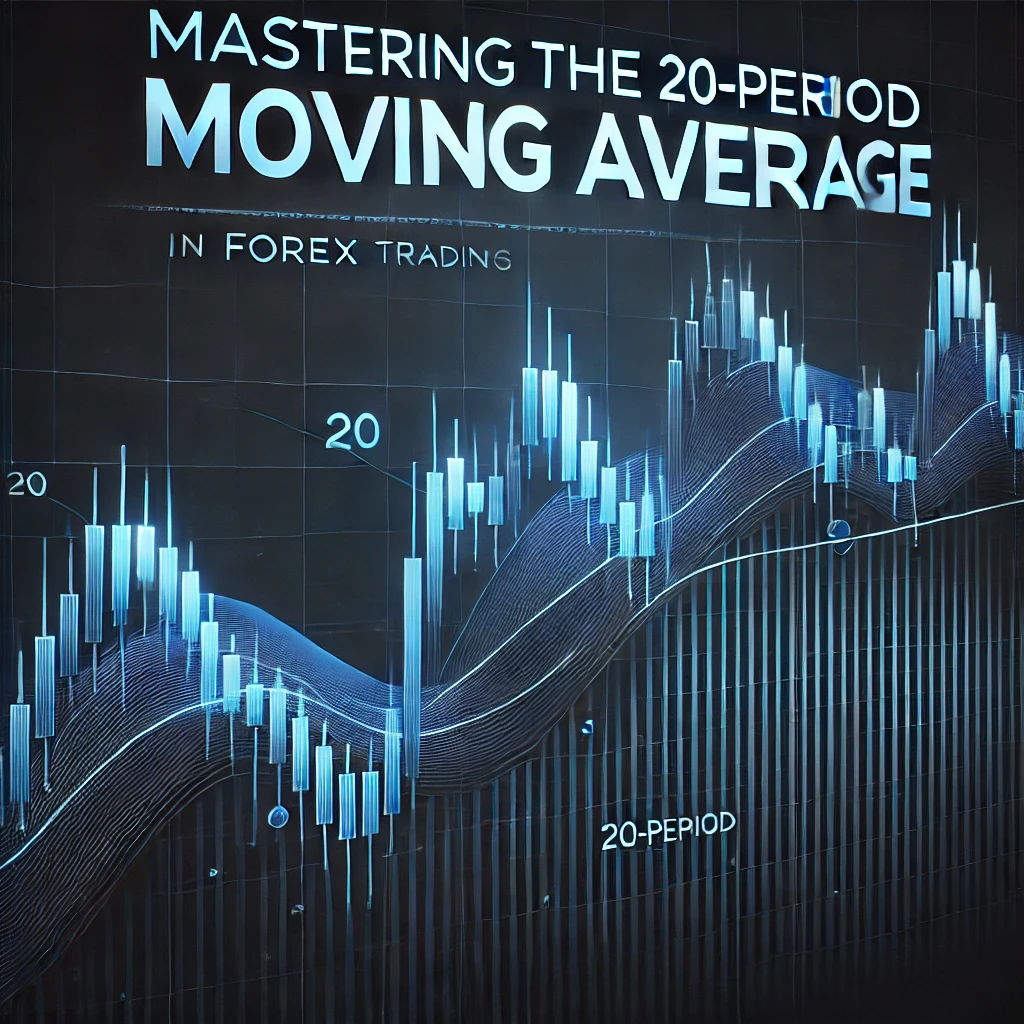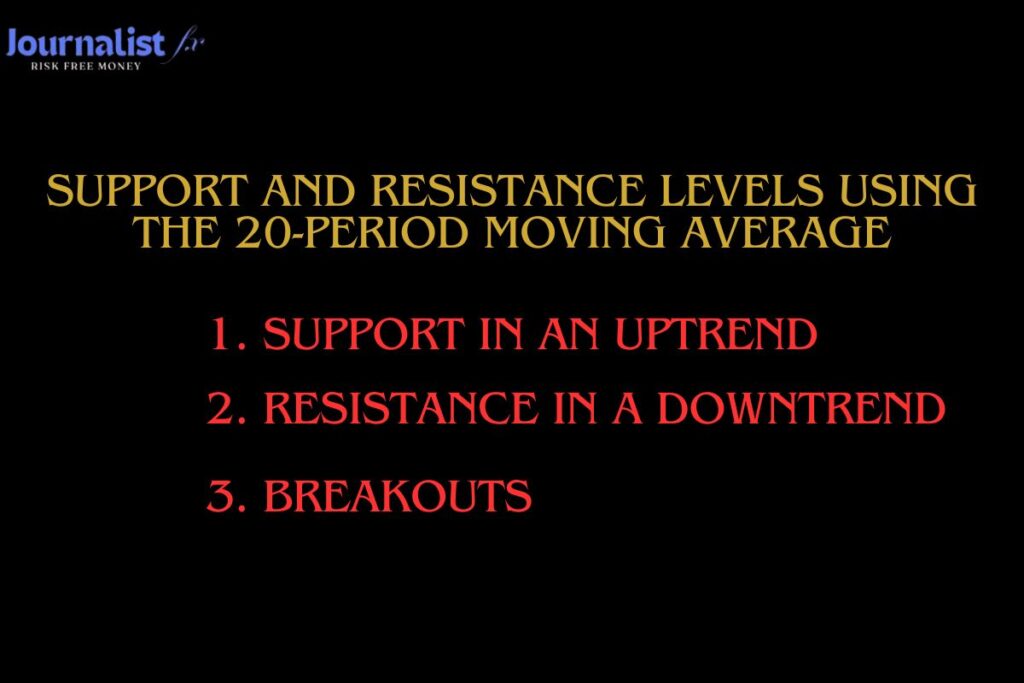Forex traders worldwide expose themselves to a significant amount of threat while trading. The price movements are unpredictable, while a trend may shift quickly. The traders need a reliable tool by which they can implement their strategies as planned. One such simple and effective tool is the 20-period moving average. Mastering the 20-period moving average is a must for traders. Those looking to capitalize on short- to medium-term trends. This tool is vital. It sets a high standard. When used with precision and skills, it can increase the winning percentage. The 20-period moving average is a valuable tool for risk management, too.
You can see the importance of the 20-period moving average on price charts. It acts as a dynamic reference point. It also provides a clearer view to traders for executing their trades. It doesn’t matter if you are working on a 15-minute or daily chart, as it helps to highlight the overall trend. To find these points, traders can execute buying and selling opportunities efficiently.
In this article, we will explore more on the 20-period moving average. Understanding how it can help our trading experience by identifying correct market trends. A well-established fact is that popular indicators can improve your trading. This is true for both beginners and experienced traders.

Understanding the 20-Period Moving Average
The 20-period moving average is a popular technical indicator. Traders use it to visualize market trends.
“To be a successful forex trader, you must efficiently use this technical indicator.”
- It can work over any time frame, calculating the average price of an asset over the last 20 candles (or periods).
- The experts recommend the tool for short-term and medium-term traders.
Benefits of the 20-Period Moving Average
- One of the most popular advantages of this indicator is that it provides stability and balance to fluctuating price changes.
- The other good thing is that it doesn’t offer false signals while tracking recent price movements.
- It helps traders to have a complete understanding of market trends
Key Features of the 20-Period Moving Average
As it is already established through the blog, using the 20-period moving average is crucial. Let us find some of its key features.

1. To Identify Trends
Traders use this indicator to predict market trends. There are 2 cases. If the price stays over MA, it will be an uptrend. If the price stays below MA, it represents a downtrend.
2. Support and Resistance
- The 20-point moving average can act as dynamic support in an uptrend. In a downtrend, it acts as support.
- Traders can identify entry and exit points when they know about support & resistance levels.
3. Smoothing Out Price Fluctuation
Traders use the 20-point moving average to smooth out random price changes. It helps traders focus on the bigger picture and hold on to the trades in random price fluctuations.
Comparing the Simple Moving Average (SMA) and the Exponential Moving Average (EMA)
Forex traders around the world use both of these tools. These tools help to smooth out the price fluctuations. They also help to identify the market trend. I decided to compare them both so that you can get a clear picture of how to have their practical use.

1. Simple Moving Average (SMA)
- The critical difference between the two is the importance given to the closing price of periods in the calculation.
For example, the calculation of the 20-period SMA considers each period’s closing price as exact.
- SMA is less sensitive to sudden price changes. It responds to price changes with a time delay.
Possible reason: It gives equal importance to all periods in the calculation.
- Traders prefer SMA when looking for a less reactive view of trends.
It helps traders see a broader image of the market.
2. Exponential Moving Average (EMA)
- EMA is more sensitive to current market movements. It gives more weight to recent prices.
Used by: EMA is more helpful to short-term traders as they look for time signals with greater frequency.
- Traders prefer it in a volatile or a market that triggers a lot.
3. Difference Between SMA and EMA
| Simple Moving Average (SMA) | Exponential Moving Average (EMA) |
| In calculation, SMA gives equal weight to all periods. | EMA has less lag as it focuses on the latest prices. |
| SMA lags more as it averages out price with equal weight given to each price. | EMA gives more weight to recent prices. It is more responsive to price changes. |
| Ideal for traders who are looking at long-term trends in the market. | Ideal for gaining profit in the short-term trend. |
Calculating the 20-Period Period Moving Average
Calculating the 20-period moving average gives a trader clarity about price trends. It allows them to introspect the entry and exit points of an asset.
How it is done
It is very simple to calculate a 20-point moving average. You can calculate it by taking the average price of an asset over the last 20 candles or periods. The calculation may vary depending on what type of moving average you are using. It can be exponential or simple.
1. Simple Moving Average (SMA)
SMA gives equal weight to each of the 20 periods.
SMA = (P1 + P2 + P3 + … + P20) / 20. Here, ‘P’ represents the closing price of a candle. So, the closing price from period 1 to 20 takes its average.
Let me explain it with an example.
- The closing price of candles over the last 20 periods is 1.3000, 1.3010, etc.
- We will add them all.
- Divide by 20 to get SMA.
2. Exponential Moving Average (EMA)
EMA gives extra weightage to recent prices, making it more responsive to recent market activities.
EMA = [(Price – EMA previous) / Multiplier] + EMA previous.
Price is current candles or period closing price.
EMA previous is the EMA value of the previous period or candle.
Multiplier = 2 / (n + 1). In this case, n = 20.
Let me explain it with an example.
- Calculate SMA for the initial 20 periods to get the initial EMA.
- Multiplier = 2 / (20 + 1) = 0.0952
- Now, use the formula to get a new EMA value.
Note: EMA reacts to price changes faster than SMA as it gives more weight to recent prices. EMA is ideal for traders who want to check recent price trends.
Support and Resistance Levels Using the 20-Period Moving Average
The 20-period moving average has two advantages. It helps to identify market trends and the level of support and resistance. Let’s examine how to identify support and resistance using a 20-period MA.

1. Support in an Uptrend
The 20-point MA acts as potential support when the price uptrends. When the price drops, it will find support near the MA before rising again.
How to Use (Buying Position)
You have to observe the price. Suppose it touches or even gets close to the 20-period MA during an uptrend. The price may take support from the MA and bounce upward. It is a buying position.
Example: Consider monitoring an uptrend. If the price dips and again moves upward, the MA acts as a support level.
2. Resistance in a Downtrend
Consider monitoring a downtrend market if a 20-period MA prevents the price from rising above it. It is acting as a potential resistance.
How to Use (Selling Position)
Consider the market to be in a downtrend. The price touches the 20-period MA and gets pulled down again. In that case, the MA is acting as a potential resistance. It is a perfect selling position.
Example: If the price moves toward the 20-period MA and fails to break above it. It acts as resistance. Starting to short the position is the sign.
3. Breakouts
Breakout is when the price surges above resistance or below support. Let us confirm a breakout using the 20-period MA.
There are two conditions to monitor:
- If the price breaks above MA and holds there. It may suggest that the downtrend is over and the uptrend is starting.
- If the price breaks below MA and holds there in an uptrend. It may indicate the beginning of a reversal.
Trade Reversal and Pullbacks Using the 20-Period Moving Average
It is an excellent tool for finding entry and exit points based on price relative to the moving average. It also helps to create positions during trend reversals or pullbacks.
There are two possibilities for using a 20-period moving average.
Trend reversals and pullbacks in an existing trend.

1. Pullbacks in an Existing Trend
A pullback is when there is a brief opposite movement of the price of the current trend. In simple words, an uptrend pullback is a short dip in price or vice versa.
| Uptrend | Downtrend |
| Condition 1: When the price is above the 20-point SMA. SMA acts as Dynamic Support. | Condition 1: When the price is below the 20-point SMA, SMA acts as Dynamic Resistance. |
| Condition 2: 20-point SMA creates potential buying opportunities when there is a Pullback. Traders wait for the price to bounce off the SMA. | Condition 2: A Pullback to the 20-point SMA creates selling opportunities. Traders wait for signs as the price fails to break above the SMA. |
| Example: If the price bounces upward after a pullback to the 20-point SMA, it confirms that the uptrend is intact. | Example: If the price moves up to 20-point SMA and reverses down. Traders may enter in a short position. |
2. Trend Reversal
As the name suggests a trend reversal if the price moves from an uptrend to a downtrend or vice versa.
| Up to Downtrend | Down to Uptrend |
| The price confirms the uptrend as it stays above the 20-point SMA. A reversal happens when the price moves below the 20-point SMA and stays there. | The price confirms a downtrend by staying below the 20-point SMA. A reversal happens when the price moves upward to the 20-point SMA and stays there. |
| Before entering a short position, a trader checks lower highs or volume indicators. They do not rely on the break signal of trend reversal. | Before opening a buying position, the trader checks volume indicators or higher lows. They do not rely on the break signal of trend reversal. |
Tips: Doji or engulfing candles near the 20-period moving average can confirm a pullback or reversal.
Market Analysis Using the 20-Period Moving Average
- 20-period MA could smooth out recent price fluctuations. It offers a clearer view of the market’s overall direction. Many traders around the world use it to predict and analyze market movement.
- Traders can apply it across different time frames. It is a good tool for intraday trading or long-term trading.
Traders can use it to identify market trends. It can be an uptrend, downtrend, or sideways movement.

1. Trend Direction
Condition 1 (Uptrend): If the price keeps floating over the 20-period SMA and slopes upwards. The market is going to remain in an uptrend. Traders usually open a buying position or hold in such a scenario.
Condition 2 (Downtrend): If the price keeps floating below the 20-period SMA and slopes downward. The market is going to remain in a downtrend. Traders usually sell or hold short positions in such a scenario.
Condition 3 (Ranging Market): This is a typical condition for trade when there is no indication of the trend. Price will fluctuate around the 20-period SMA without a clear slope. In other words, the market is range-bound.
Tip: As a beginner, avoid trading in a range-bound market. Trade when there are clear indications of either a downtrend or an uptrend.
2. Trend Reversals
Condition 1 (Bullish Reversal): When the price moves above the 20-period SMA and holds. This generally occurs after a bearish rally. The game is changing, or the trend reverses from bearish to bullish. Time to open buying positions.
Condition 2 (Bearish Reversal): When the price moves below the 20-period SMA and holds. The market triggers a bearish rally. Time to short-sell.
3. Crossovers
Condition 1 (Bullish Cross): A crossover generally occurs when a faster-moving average (e.g., 10-period SMA) crosses above the 20-period SMA. This is a bullish crossover. It indicates the market may be starting an uptrend.
Condition 2 (Bearish Cross): It happens when a faster moving average crosses below the 20-period SMA. This is a bearish crossover. It indicates the market may be starting a downtrend.
Conclusion
We have started this blog by exploring and mastering the 20-period moving average. It is a critical tool. Using it well can have a profound positive effect on our trading. It can also be used as a risk management tool. We can minimize our loss and move towards a profitable trade with its optimum use. It helps to understand the trend of the market and gives a chance to traders with a profitable execution of a trade. Whether you’re a day trader or a long-term player is fine. Mastering a 20-period moving average will enhance your trading experience. It provides excellent market insight and trading opportunities.
Frequently Asked Questions
The 20-period MA is a technical indicator that can improve the trading experience. Let me explain it with the help of an example. Let us assume you’re trading in a sideways market. The asset price closes above the 20-period MA with substantial volume. It indicates a breakout with a buying opportunity. If the price drops below the 20-period MA after an uptrend. It suggests a pullback or reversal.
Catching a market can be crucial while you trade. It will decide the profitability of our trade. Let me give you an example where you can find a trend using the 20-point MA. Suppose you’re trading in a sideways market when the price exceeds the 20-period MA. It stays there, making higher highs and higher lows. This indicates a new uptrend has been set. Use the MA as a stop loss; you can enter a buy position when the price moves above the MA. This has helped you to catch a trend early. You can exit before the trend reverses.
It is essential to identify the support and resistance levels of the market. They can help you decide when to enter and exit a trade. Finding resistance and support are two scenarios.
1. During an uptrend, the 20-point MA can act as a support. In case the price bounces off it in an upward direction.
2. During a downtrend, the 20-point MA can act as a resistance if it prevents the price from rising above it.
A stock has been moving in a particular range for a while. The 9 EMA is below the 21 EMA and the scenario changes. Now, the 9 EMA crosses above the 21 EMA. Remember to check the volume to confirm that it is a buying position. If it is increasing, it is a perfect buying position. If the 9 EMA stays above the 21 EMA, hold your trade; otherwise, exit.
This strategy works in a long-term position. You have been following a stock for months. The 20 EMA is below the 200 EMA, which indicates a downtrend. Recently, the price has been moving up and crossed the 200 EMA. This is a “golden cross” signal. It suggests the trend is now favoring a buy. Traders can build a long position from here. They should hold till the 20 EMA stays above the 200 EMA if it gets below. It is a reversal sign. Exit your trades.
